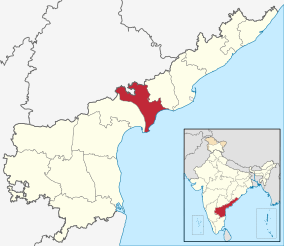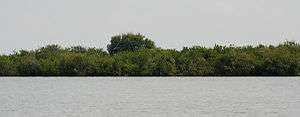Krishna Wildlife Sanctuary
| Krishna Wildlife Sanctuary | |
|---|---|
|
IUCN category IV (habitat/species management area) | |
|
Mangroves in Krishna Wildlife Sanctuary, Andhra Pradesh, India | |
 Location of Krishna Wildlife Sanctuary in Andhra Pradesh, India | |
| Location | Andhra Pradesh, India |
| Nearest city | Machilipatnam |
| Coordinates | 15°46′27″N 80°56′39″E / 15.77417°N 80.94417°ECoordinates: 15°46′27″N 80°56′39″E / 15.77417°N 80.94417°E[1] |
| Area | 194.81 km2 (48,140 acres) |
| Governing body | Andhra Pradesh Forest Department |
Krishna Wildlife Sanctuary is a wildlife sanctuary and estuary located in Andhra Pradesh, India.[2] It is one of the rarest eco-regions of the world owing to the fact that it harbors vast tracts of pristine mangrove forests. It is believed among conservationists as one of the last remaining tracts of thick primary mangrove forests of South India, which is rapidly disappearing due to absence of protective measures.[3]
Geography
The sanctuary is a part of the mangrove wetland in Andhra Pradesh and are located in the coastal plain of Krishna delta.
The Krishna mangroves lie between 15° 2' N and 15° 55' N in latitude and 80° 42'- 81° 01' E in longitude spread across Krishna and Guntur districts of Andhra Pradesh.
It includes Sorlagondi Reserve Forest, Nachugunta Reserve Forest, Yelichetladibba Reserve Forest, Kottapalem Reserve Forest, Molagunta Reserve Forest, Adavuladivi Reserve Forest and Lankivanidibba Reserve Forest. They occupy the islands of the delta and the adjacent mainlands of Krishna and Guntur Districts.
A part of the mangroves is located far from the main mangrove area. This unconnected regions lies near Machilipatnam on its eastern side and Nakshatranagar on its western side.
Flora and fauna
The estuary of Krishna River passes through the sanctuary, and the mangroves line the estuary. It is believed that this region potentially holds one of the most significant populations of fishing cats in the world and yet, no concrete surveys on fishing cats or community-based fishing cat conservation efforts have been carried out here.[4] The area has the potential to become world's first reserve for a few of the IUCN identified endangered species including the fishing cat (Prionailurus viverrinus) or better known locally as bavuru pilli.[5]
Some of the tree species found in the sanctuary are: Casuarina equisetifolia, Pongamia gladra, Calotropis gigantea, Cassia auriculata, Thespesia populnea, Ipomaea biloba, Spinifex squarrosus, Spinifex littoreus, Pongamia pinnate, Prosopis juliflora, banyan, peepul, margosa, tumma, mango, palmyra.
_W_IMG_6807.jpg)
The sanctuary is home for reptiles like garden lizard, wall lizard and tortoise.
Snakes[6]
| Common name | Formal name | Status | Common name | Formal name | Status | |
|---|---|---|---|---|---|---|
| Indian python | Python molurus | - | Common cobra | Naja naja | - | |
| Common sand boa | Eryx conicus | - | Russell's viper | Vipera russelli | - | |
| John's sand boa | Eryx johnii | - | Saw-scaled viper | Echis carinatus | - | |
| Common wolf snake | Lycodon aulicus | - | Bamboo pit viper | Trimeresurus gramineus | - | |
| Common kukri snake | Oligodon arnensis | - | Shaw's wolf snake | Lycodon striatus | rare | |
| Striped keelback snake | Amphiesma stolata | - | Twin-spotted wolf snake | Lycodon jara | rare | |
| Chequered keelback snake | Xenochrophis piscator | - | Gunther's racer | Argyrogena gracilis | rare | |
| Common trinket snake | Elaphe helena | - | Smooth snake | Coronella brachyura | rare | |
| Rat snake | Ptyas mucosus | - | Painted bronzeback | Dendrelaphis pictus | rare | |
| Common Indian bronzeback | Dendrelaphis tristis | - | Condanorus sand snake | Psammophis condanarus | rare | |
| Common green whip snake / Asian vine snake | Ahaetulla nasuta | - | Stout sand snake | Psammophis longifrons | rare | |
| Common cat snake | Boiga trigonata | - | King cobra | Ophiophagus hannah | rare | |
| Common krait | Bungarus caeruleus | - |
The amphibian fauna present in the sanctuary include the common frog, the otter and the saltwater crocodile.
The herbivorous species present are spotted deer, sambar and black buck.
Other species found in the sanctuary are hyena, jungle cat, fox and bear.
Avifauna include crested serpent eagle, Indian roller, wagtails and pipits.
See also
References
- ↑ "ATLAS OF MANGROVE WETLANDS OF INDIA" (PDF). Retrieved 2012-07-30.
- ↑ "APFD Website". Forest.ap.nic.in. Retrieved 2012-07-30.
- ↑ http://www.newindianexpress.com/states/andhra_pradesh/Wetlands-Shrink-to-17K-Acres-in-Krishna-District/2014/02/24/article2074352.ece
- ↑
- ↑ http://www.fishingcat.org/fishing-cat-resources-1.html
- ↑ Gupta, Harsh K.; Parasher-Sen, Aloka; Balasubramanian, Dorairajan (2000). Deccan Heritage. Hyderabad, India: Universities Press. pp. 50–51. ISBN 978-81-7371-285-2.
External links
- Krishna wildlife sanctuary from Forest Department of Andhra Pradesh (India) State Government website
- Forest Department of Andhra Pradesh (India) State Government website
| Wikimedia Commons has media related to Krishna Wildlife Sanctuary. |





_in_Kolleru%2C_AP_W_IMG_4052.jpg)